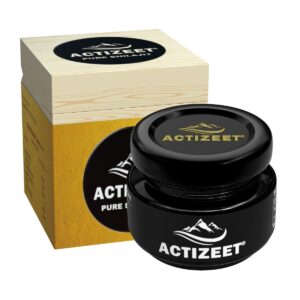Shilajit, a fascinating substance steeped in mystery and ancient wisdom, has captured the attention of health enthusiasts and practitioners worldwide. This remarkable substance is formed over centuries through the gradual decomposition of plant materials in the cracks and crevices of rocky mountains. Originating from the Himalayan and Altai regions, Shilajit is rich in minerals, organic compounds, and fulvic acid, making it highly sought after for its potential health benefits.
Table of Contents
ToggleDefinition and Origin of Shilajit
Shilajit derives its name from Sanskrit roots: “shila,” meaning rock or stone, and “jatu,” meaning lac or gum. It perfectly encapsulates its essence as a tar-like resin that emerges from ancient rocks. Found predominantly in high-altitude regions with unique geological formations, such as the Himalayas and Altai Mountains, this natural wonder has been used for centuries in traditional Ayurvedic medicine.
Importance and historical use of Shilajit in traditional medicine
Ancient cultures revered Shilajit for its esteemed medicinal properties. In Ayurveda, one of the world’s oldest healing systems originating from India, it holds a significant place as an adaptogenic substance believed to restore balance to the body.
Traditional healers viewed it as a rejuvenating elixir capable of promoting vitality and longevity. The historical use of Shilajit spans across various civilizations.
In Indian folklore, it is considered a powerful aphrodisiac known to enhance sexual performance and fertility. In Tibetan medicine, it is hailed as a potent energy booster that supports physical strength and mental clarity.
Even ancient Greeks valued this resin-rich substance for its ability to improve overall well-being. Rich in minerals like iron, calcium, and magnesium, Shilajit has been used as a natural supplement to address a wide range of health concerns.
Its purported benefits include boosting the immune system, enhancing cognitive function, reducing inflammation, improving stamina and vitality, and promoting anti-ageing effects. While modern scientific research is still uncovering the full extent of Shilajit’s potential benefits, its historical significance and enduring popularity in traditional medicine certainly add to its allure.
Understanding the Purity of Shilajit
Factors influencing the purity of Shilajit
Shilajit’s purity can be affected by various factors, which play a crucial role in determining its overall quality. Firstly, the geological formation and source location greatly impact the purity of Shilajit.
The regions where this remarkable substance is found can vary in terms of mineral composition and environmental conditions, which ultimately influence its purity levels. Shilajit, sourced from pristine mountainous regions at higher altitudes tends to have a higher likelihood of being pure.
Geological formation and source location
The geological formation and source location significantly contribute to the purity of Shilajit. Genuine Shilajit is formed over centuries through the decomposition of plant matter trapped in mountain crevices or rocks. The specific geological conditions, such as pressure, temperature, and types of rocks involved in this process, have a direct impact on the resulting quality and purity of Shilajit.
Extraction methods and processing techniques
The extraction methods employed during the collection process also play a crucial role in determining the purity of Shilajit. Traditional extraction methods involve carefully collecting resin-like deposits that naturally exude from rocks or crevices.
This manual collection method minimizes contamination risks while preserving its natural properties. However, modern extraction techniques using chemical solvents or high heat can potentially compromise its purity by introducing contaminants or altering its chemical composition.
Presence of impurities or contaminants
The presence of impurities or contaminants is another significant factor when evaluating the purity level of Shilajit. While it naturally contains beneficial minerals and organic compounds, impurities like soil particles, microbial growth, or plant debris may be present due to inadequate processing techniques or improper storage conditions.
Contaminants such as heavy metals or pesticide residues can also find their way into low-quality or adulterated Shilajit, compromising its purity and potentially posing health risks. Therefore, thorough quality control measures and adherence to strict processing guidelines are essential to ensure the absence of impurities in pure Shilajit.
Understanding these factors and their influence on the purity of Shilajit is crucial for consumers who seek authentic and high-quality products. The next section will delve into identifying pure Shilajit based on its physical characteristics and chemical composition analysis.
Identifying Pure Shilajit
Physical characteristics of pure Shilajit: Unmasking Nature’s Brilliance
When it comes to identifying pure Shilajit, its physical characteristics are like nature’s signature stamp. Pure Shilajit boasts a remarkable colour, texture, and consistency that sets it apart from its inferior counterparts. Authentic Shilajit typically exhibits a dark brown to blackish hue, reminiscent of the rich earth from which it emerges.
Its texture is akin to a thick resin or tar-like substance, with a glossy appearance that reflects light like a shimmering gemstone. As for consistency, pure Shilajit possesses a dense and cohesive nature that allows it to retain its shape when handled but easily dissolves in warm water or milk.
Odor and taste profile: A Whiff of Excellence
Unveiling the true essence of pure Shilajit requires an olfactory journey into its captivating aroma and an exploration of its unique taste profile. The aroma is often described as potent and earthy, evoking memories of ancient forests after a gentle rain shower. The scent carries hints of muskiness intertwined with herbal notes, leaving one with an indescribable sense of connection to the natural world.
When it comes to taste, authentic Shilajit exhibits a complex yet pleasant flavour profile. It can be slightly bitter at first encounter but transforms into a nuanced amalgamation of sweetness and mild tanginess as it lingers on the palate.
Chemical composition analysis for purity assessment: Unlocking Nature’s Secrets
Delving deeper into the purity assessment process entails scrutinizing the chemical composition that defines authentic Shilajit’s potency. Within this wondrous substance lie organic compounds that contribute to its remarkable health-enhancing properties.
One such compound is fulvic acid—a key player that endows Shilajit with its unique characteristics. Fulvic acid not only aids in nutrient absorption and detoxification but also acts as a natural antioxidant.
Another essential component is humic acid, which supports the body’s immune system and promotes overall well-being. Additionally, trace minerals and nutrients present in pure Shilajit, such as iron, magnesium, zinc, and vitamin B12, further reinforce its beneficial effects on the human body.
These constituents are like nature’s hidden treasures waiting to be unleashed. With physical characteristics that mesmerize the senses and a chemical composition that promises unparalleled health benefits, pure Shilajit stands as a testament to nature’s brilliance.
Authenticating Sources for Pure Shilajit
Sourcing from reliable regions known for high-quality Shilajit
When it comes to determining the purity of Shilajit, one crucial aspect is the sourcing of this miraculous substance. To ensure you are getting a pure and authentic product, it is essential to consider the region from which the Shilajit originates.
High-quality Shilajit is primarily found in specific regions known for their pristine environments and ideal geological conditions, such as the Himalayas, Altai Mountains, and Caucasus Mountains. These areas are characterized by their remote locations and untouched ecosystems, which significantly contribute to the purity and potency of the collected resin.
Altitude, climate, and geological factors affecting purity
The altitude at which Shilajit is sourced plays a vital role in determining its purity. Higher altitudes often boast colder climates with minimal human interference or pollution. This results in cleaner air quality and reduced contamination risk for the plants that produce Shilajit resin.
Additionally, geological factors like unique rock formations rich in minerals have contributed to the formation of high-quality Shilajit over centuries. These factors influence both the composition and concentration of beneficial compounds present in authentic Shilajit.
Verifying authenticity through certifications or quality standards
To further authenticate the purity of your chosen Shilajit product, it is advisable to look for certifications or quality standards associated with reputable brands. Certifications like ISO (International Organization for Standardization) or GMP (Good Manufacturing Practices) act as indicators that rigorous testing methods have been employed during the extraction, processing, and packaging stages. These certifications provide assurance that strict quality control measures have been followed to maintain the integrity of the final product.
Trusted brands with a reputation for providing pure products
Choosing a trusted brand with a solid reputation in the market is another reliable way to ensure the purity of your Shilajit. Well-established and reputable brands often prioritize sourcing their Shilajit resin from reliable regions known for high-quality production.
They invest in thorough testing procedures to guarantee that their products are free from contaminants or adulterants. Additionally, these brands have built trust over time by consistently delivering pure and potent Shilajit products, gaining the confidence of consumers seeking authentic and beneficial supplements.
By paying attention to the sourcing region, altitude, climate, geological factors, certifications, and reputable brands, you can authenticate the purity of your chosen Shilajit product. This comprehensive approach will help you make an informed decision and ensure that you are getting the genuine and effective form of this revered substance.
Potential Contaminants in Shilajit
Common Contaminants Found in Low-Quality or Adulterated Shilajits
Shilajit, with its immense popularity, is unfortunately not immune to adulteration or contamination. Unscrupulous suppliers may resort to unethical practices that compromise the purity and safety of this natural substance. One prevalent issue is the presence of heavy metals such as lead, arsenic, and mercury.
These toxic substances can find their way into shilajit during the extraction process if proper quality control measures are not followed diligently. Consumption of shilajit contaminated with heavy metals can have severe health implications, including organ damage and neurological disorders.
Heavy Metals like Lead, Arsenic, Mercury
Lead, arsenic, and mercury are dangerous heavy metals that should never be present in shilajit. Lead exposure can lead to impaired cognitive function and developmental delays in children. Arsenic is a known carcinogen that can cause various cancers such as skin, lung, bladder, kidney, and liver cancer when ingested over prolonged periods.
Similarly, mercury poisoning affects the central nervous system and can result in symptoms like memory loss and tremors. To ensure your shilajit is pure, it’s crucial to choose brands that rigorously test their products for these harmful heavy metals.
Pesticide Residues from Improper Sourcing or Cultivation
Another potential contaminant in shilajit comes from pesticide residues when improper sourcing or cultivation methods are employed. Some unscrupulous suppliers may use pesticides during plant cultivation without adhering to environmental regulations or recommended dosage limits.
This irresponsible use of pesticides leads to the accumulation of harmful residues within the plants used for shilajit production. Consumption of shilajit containing pesticide residues can pose health risks, including gastrointestinal issues, skin irritations, and even long-term effects on the nervous system.
It is crucial to opt for shilajit brands that prioritize sustainable and organic cultivation practices to avoid exposure to pesticide residues. It is essential to be aware of potential contaminants when seeking pure shilajit.
Heavy metals like lead, arsenic, and mercury should never be present in this natural substance as they can cause severe health problems. Pesticide residues from improper sourcing or cultivation can also compromise the purity of shilajit and have detrimental effects on our well-being.
To ensure you are consuming a pure product free from these contaminants, it is imperative to choose reputable brands that prioritize rigorous testing and adhere to proper cultivation practices. Stay informed and make an educated choice when selecting your shilajit source for a safe and beneficial experience.
Testing Methods to Ensure Purity
Laboratory testing procedures used to assess shilajit
When it comes to determining the purity of Shilajit, laboratory testing plays a crucial role. Various methods are employed by reputable manufacturers and independent labs to ensure that the product meets the required standards. One common method is High-Performance Liquid Chromatography (HPLC), which allows for the separation and identification of different compounds in Shilajit.
This technique helps identify the presence of fulvic acid, humic acid, and other organic components, ensuring that the product is genuine and pure. Additionally, Inductively Coupled Plasma Mass Spectrometry (ICP-MS) is often used to detect any heavy metal contamination in Shilajit.
This technique enables scientists to accurately quantify trace amounts of metals such as lead, mercury, or arsenic. By setting strict permissible limits for these contaminants, manufacturers can guarantee that their products are safe for consumption.
Conclusion
Determining which Shilajit is pure requires a comprehensive understanding of various factors influencing its quality. Through careful assessment of physical characteristics and chemical composition analysis, one can ascertain the authenticity of this remarkable substance. It is also vital to source Shilajit from reliable regions known for high-quality production and verify authenticity through certifications or adherence to quality standards like ISO or GMP.
By employing rigorous laboratory testing methods such as HPLC and ICP-MS, manufacturers can ensure that their Shilajit products are free from impurities or contaminants. Choosing reputable brands with a commitment to quality becomes paramount in securing a pure and potent form of this natural wonder.
Embarking on a journey with pure Shilajit not only introduces you to its potential health benefits but also grants you peace of mind knowing you’re consuming a product derived from nature’s bounty. So, embrace the purity of Shilajit and let its ancient wisdom revitalize your well-being with its innate power.
The Purest Shilajit
-
Himalayan Shilajit, Pure shilajit, Shilajit, SHUDDH SURYA TAPI SHILAJIT
Rated 4.74 out of 5₹4,950.00Original price was: ₹4,950.00.₹3,950.00Current price is: ₹3,950.00. Incl. GST ADD TO CART Buy Now -
Himalayan Shilajit, Pure shilajit, Shilajit, SHUDDH SURYA TAPI SHILAJIT
Rated 4.78 out of 5₹9,900.00Original price was: ₹9,900.00.₹6,450.00Current price is: ₹6,450.00. Incl. GST ADD TO CART Buy Now -
Himalayan Shilajit, Pure shilajit, Shilajit, SHUDDH SURYA TAPI SHILAJIT
Rated 4.74 out of 5₹3,450.00Original price was: ₹3,450.00.₹2,450.00Current price is: ₹2,450.00. Incl. GST ADD TO CART Buy Now -
Himalayan Shilajit, Pure shilajit, Shilajit, SHUDDH SURYA TAPI SHILAJIT
Rated 4.81 out of 5₹8,400.00Original price was: ₹8,400.00.₹5,450.00Current price is: ₹5,450.00. Incl. GST ADD TO CART Buy Now
Related posts:
- Unveiling the Purest Shilajit Brand: Discover Which Brand Reigns Pure
- Unveiling the Ultimate Shilajit Resin: Discovering the Best Pick
- Unveiling the Best Shilajit in India: Your Ultimate Guide
- Unveiling the Best Shilajit: Which Brand Reigns Supreme?
- Unveiling the Best Shilajit: Discovering Which Shilajit is Good
- Unlocking the Mysteries: Unveiling Why Actizeet Shilajit Commands a Premium Price
- Unveiling the Mystery: When Does Shilajit Expire? | Expert Insights
- Unveiling the Intricacies: How Shilajit is Extracted







